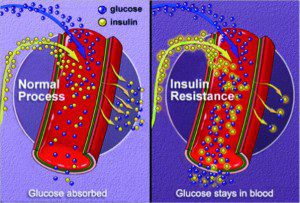By Ray Lenius, RCIS and Leslie Yaniga, RCIS, Faculty, Cardiovascular Technology, FSW
 Coronary Heart Disease (CHD) is the number one killer of men and women in the United States. According to the Centers for Disease Control and Prevention (CDC), more than 370,000 people die annually from coronary heart disease. One cause of CHD that is most often in the news is high cholesterol. The main focus of prevention is on reducing the amount of bad fats, such as saturated and trans fatty acids, and increasing the good fats, such as unsaturated fats. Good fats are needed for our body to function properly, however, another risk factor for CHD is Diabetes Mellitus (DM) and this has been over shadowed by the talk of reducing cholesterol.
Coronary Heart Disease (CHD) is the number one killer of men and women in the United States. According to the Centers for Disease Control and Prevention (CDC), more than 370,000 people die annually from coronary heart disease. One cause of CHD that is most often in the news is high cholesterol. The main focus of prevention is on reducing the amount of bad fats, such as saturated and trans fatty acids, and increasing the good fats, such as unsaturated fats. Good fats are needed for our body to function properly, however, another risk factor for CHD is Diabetes Mellitus (DM) and this has been over shadowed by the talk of reducing cholesterol.
Diabetes mellitus is a disorder in which blood sugar (glucose) levels are abnormally high because the body does not produce enough insulin to meet its needs or the body is unable to use the insulin that is produced. There are two types of DM. Type I DM is known as an insulin-dependent diabetes. In type I more than 90% of the insulin producing cells of the pancreas have been permanently destroyed by the patient’s own body. This is known as an autoimmune disease.
The increased risks of CHD for people with type I DM is believed to be the result of this autoimmune disease. Not only does it attack the pancreas, it may also attack the blood vessels of the body.
Type II DM is a non-insulin-dependent diabetes. This will differ from type I in that the pancreas continues to produce insulin. At times, the amount of insulin produced may be higher than normal. With type II DM, the body develops a resistance to the effects of insulin resulting in too little insulin to meet the body’s needs. According to the CDC, approximately 29 million people in the United States are diabetic. Diabetes mellitus affects many parts of the body in a negative way and can cause CHD.
In type II DM, the ability of the blood vessels to prevent inflammation (swelling) is compromised by the high sugar level. People with type II DM may have additional risk factors such as high blood pressure, high cholesterol, high triglycerides, obesity, smoking, and lack of physical activity.
The best way to reduce the risk of CHD in type I DM is to control blood sugar levels. This can done by frequently checking blood sugar and taking insulin as needed. The goal is to keep blood sugar levels as close to normal as possible. This will help to delay or prevent complications. The general goal for sugar levels is to keep your daytime blood sugar levels before meals between 70 and 130 mg/dl or no higher than 180 mg/dl two hours after eating. Other ways to control blood sugar levels are carbohydrate counting, eating healthy foods, exercising regularly, and maintaining a healthy weight.
While type I DM may not be preventable, type II DM is preventable. The biggest cause of type II DM is obesity. The best treatment for type II DM is prevention by losing extra pounds, eating better, and becoming more active. As with type I DM, it is important to monitor and control blood sugar levels, which should be maintained the same in type II DM as in type I. Besides insulin, several oral medications, such as Glucophage, can be taken to control blood sugar levels. Ways to control type II DM include exercising regularly and eating a healthy diet. A healthy diet will include foods that are high in fiber and low in fat. Some examples of these foods are fruits, vegetables, and whole grains.
Everyone strives to have a healthy life style and to live a long life. Visiting your doctor, eating healthy, and getting regular exercise will help to prevent or control diabetes mellitus. Doing this will help to reduce the risk of developing coronary heart disease and having a heart attack.
Important Dates at Florida SouthWestern State College
Veteran’s Day
November 11, 2015
College Closed
Thanksgiving Holiday
November 26-29, 2015
College Closed
Priority Application Deadline
for Spring 2016 Admissions
December 4, 2015
Winter Break
December 21, 2015 – January 3, 2016
College Closed
Final Application Deadline
for Spring 2016 Admissions
January 2, 2016
Florida Southwestern State College
www.FSW.edu








